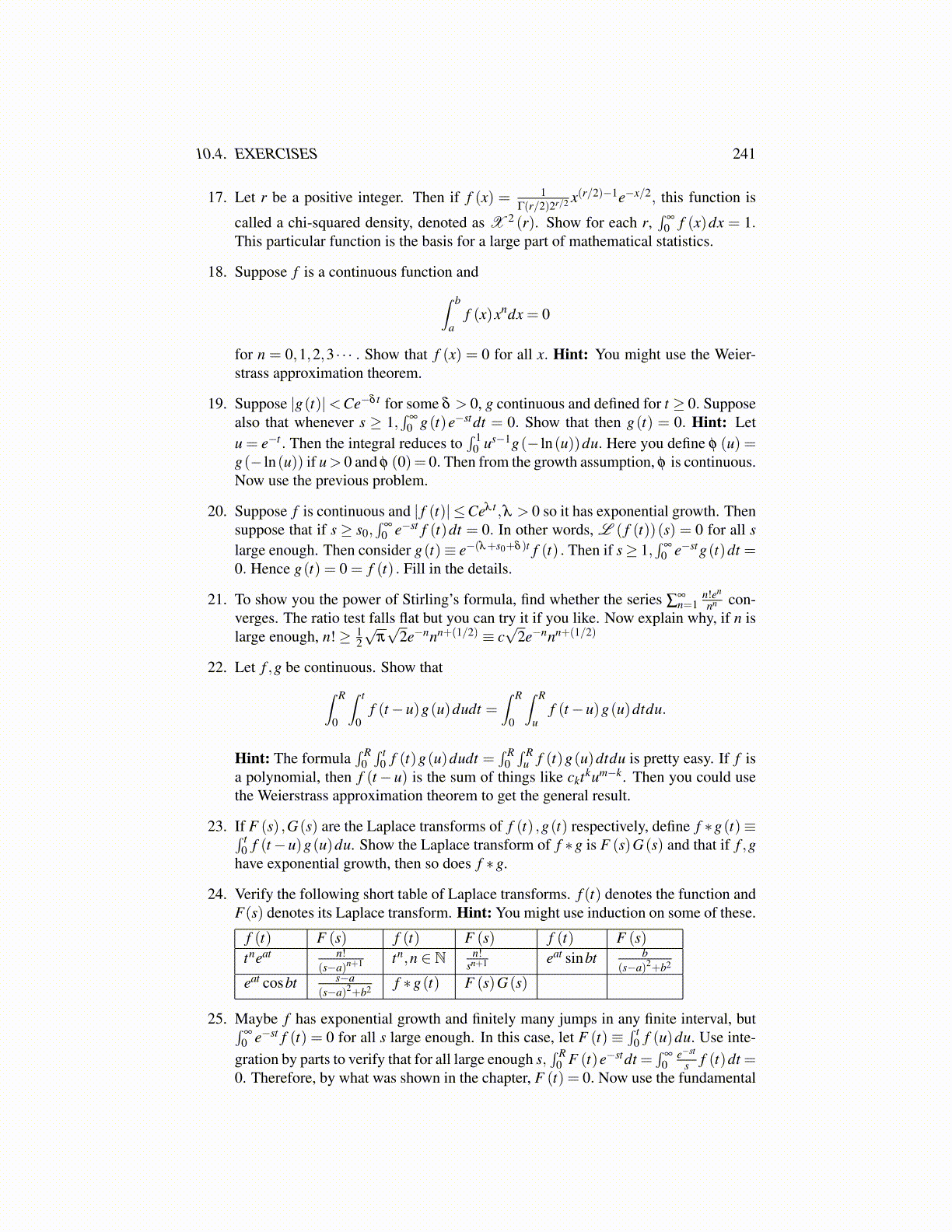
10.4. EXERCISES 241
17. Let r be a positive integer. Then if f (x) = 1Γ(r/2)2r/2 x(r/2)−1e−x/2, this function is
called a chi-squared density, denoted as X 2 (r). Show for each r,∫
∞
0 f (x)dx = 1.This particular function is the basis for a large part of mathematical statistics.
18. Suppose f is a continuous function and∫ b
af (x)xndx = 0
for n = 0,1,2,3 · · · . Show that f (x) = 0 for all x. Hint: You might use the Weier-strass approximation theorem.
19. Suppose |g(t)|<Ce−δ t for some δ > 0, g continuous and defined for t ≥ 0. Supposealso that whenever s ≥ 1,
∫∞
0 g(t)e−stdt = 0. Show that then g(t) = 0. Hint: Letu = e−t . Then the integral reduces to
∫ 10 us−1g(− ln(u))du. Here you define φ (u) =
g(− ln(u)) if u> 0 and φ (0)= 0. Then from the growth assumption, φ is continuous.Now use the previous problem.
20. Suppose f is continuous and | f (t)| ≤Ceλ t ,λ > 0 so it has exponential growth. Thensuppose that if s ≥ s0,
∫∞
0 e−st f (t)dt = 0. In other words, L ( f (t))(s) = 0 for all slarge enough. Then consider g(t)≡ e−(λ+s0+δ )t f (t) . Then if s ≥ 1,
∫∞
0 e−stg(t)dt =0. Hence g(t) = 0 = f (t) . Fill in the details.
21. To show you the power of Stirling’s formula, find whether the series ∑∞n=1
n!en
nn con-verges. The ratio test falls flat but you can try it if you like. Now explain why, if n islarge enough, n! ≥ 1
2√
π√
2e−nnn+(1/2) ≡ c√
2e−nnn+(1/2)
22. Let f ,g be continuous. Show that∫ R
0
∫ t
0f (t −u)g(u)dudt =
∫ R
0
∫ R
uf (t −u)g(u)dtdu.
Hint: The formula∫ R
0∫ t
0 f (t)g(u)dudt =∫ R
0∫ R
u f (t)g(u)dtdu is pretty easy. If f isa polynomial, then f (t −u) is the sum of things like cktkum−k. Then you could usethe Weierstrass approximation theorem to get the general result.
23. If F (s) ,G(s) are the Laplace transforms of f (t) ,g(t) respectively, define f ∗g(t)≡∫ t0 f (t −u)g(u)du. Show the Laplace transform of f ∗g is F (s)G(s) and that if f ,g
have exponential growth, then so does f ∗g.
24. Verify the following short table of Laplace transforms. f (t) denotes the function andF(s) denotes its Laplace transform. Hint: You might use induction on some of these.
f (t) F (s) f (t) F (s) f (t) F (s)tneat n!
(s−a)n+1 tn,n ∈ N n!sn+1 eat sinbt b
(s−a)2+b2
eat cosbt s−a(s−a)2+b2 f ∗g(t) F (s)G(s)
25. Maybe f has exponential growth and finitely many jumps in any finite interval, but∫∞
0 e−st f (t) = 0 for all s large enough. In this case, let F (t)≡∫ t
0 f (u)du. Use inte-gration by parts to verify that for all large enough s,
∫ R0 F (t)e−stdt =
∫∞
0e−st
s f (t)dt =0. Therefore, by what was shown in the chapter, F (t) = 0. Now use the fundamental